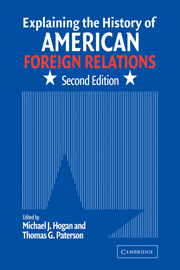Book contents
- Frontmatter
- Contents
- Preface to the Second Edition
- Contributors
- 1 Introduction
- 2 Defining and Doing the History of United States Foreign Relations : A Primer
- 3 Toward a Pluralist Vision : The Study of American Foreign Relations as International History and National History
- 4 Theories of International Relations
- 5 Bureaucratic Politics
- 6 Psychology
- 7 National Security
- 8 Corporatism
- 9 World Systems
- 10 Dependency
- 11 Considering Borders
- 12 The Global Frontier : Comparative History and the Frontier-Borderlands Approach
- 13 Modernization Theory
- 14 Ideology
- 15 Culture and International History
- 16 Cultural Transfer
- 17 Reading for Meaning : Theory, Language, and Metaphor
- 18 What's Gender Got to Do with It? Gender History as Foreign Relations History
- 19 Race to Insight: The United States and the World, White Supremacy and Foreign Affairs
- 20 Memory and Understanding U.S. Foreign Relations
- Index
8 - Corporatism
Published online by Cambridge University Press: 05 June 2012
- Frontmatter
- Contents
- Preface to the Second Edition
- Contributors
- 1 Introduction
- 2 Defining and Doing the History of United States Foreign Relations : A Primer
- 3 Toward a Pluralist Vision : The Study of American Foreign Relations as International History and National History
- 4 Theories of International Relations
- 5 Bureaucratic Politics
- 6 Psychology
- 7 National Security
- 8 Corporatism
- 9 World Systems
- 10 Dependency
- 11 Considering Borders
- 12 The Global Frontier : Comparative History and the Frontier-Borderlands Approach
- 13 Modernization Theory
- 14 Ideology
- 15 Culture and International History
- 16 Cultural Transfer
- 17 Reading for Meaning : Theory, Language, and Metaphor
- 18 What's Gender Got to Do with It? Gender History as Foreign Relations History
- 19 Race to Insight: The United States and the World, White Supremacy and Foreign Affairs
- 20 Memory and Understanding U.S. Foreign Relations
- Index
Summary
One of the challenges facing diplomatic historians is to construct an analytical framework that illuminates both the internal and external sources of foreign policy. Historians may disagree over which of these sources is more important or begin at different ends of the chain of causation. They may see American leaders as responding to the demands of a domestic system that opens outward to the world, thereby shaping the basic thrust and particular goals of diplomacy, or as reacting to imperatives embedded in the global balance of power. But wherever they start, the explanatory power of their work will be diminished if one set of sources is ignored or treated as clearly peripheral to the long-term pattern of American diplomacy. Revisionist historians, for example, have generally highlighted the domestic economic and ideological influences on policy without elaborating the geopolitical considerations that also figured in the thinking of American leaders. Postrevisionists, on the other hand, have concentrated on policymaking elites in the government and on issues of national security, including shifts in the balance of power and various strategies to contain aggressors and promote the national interest. While their approach bridges the gap between diplomatic history and political science, it fails to explore the nature of the American system or its influence on diplomacy, and thus falls short of a coherent synthesis.
- Type
- Chapter
- Information
- Explaining the History of American Foreign Relations , pp. 137 - 148Publisher: Cambridge University PressPrint publication year: 2004
- 4
- Cited by

